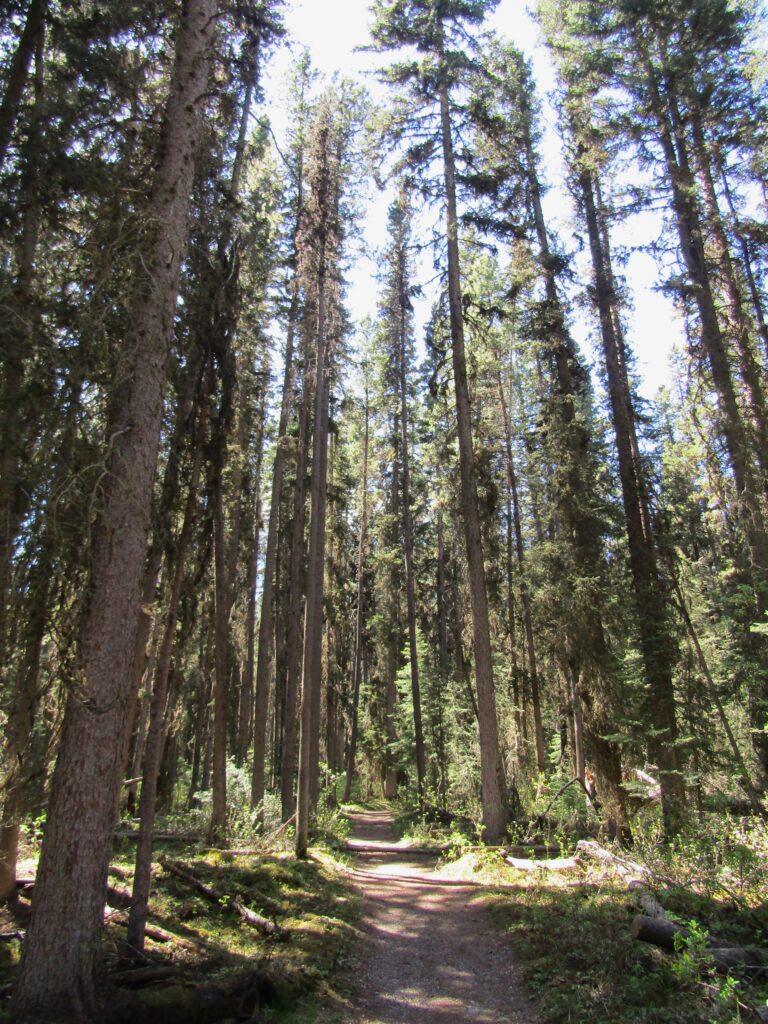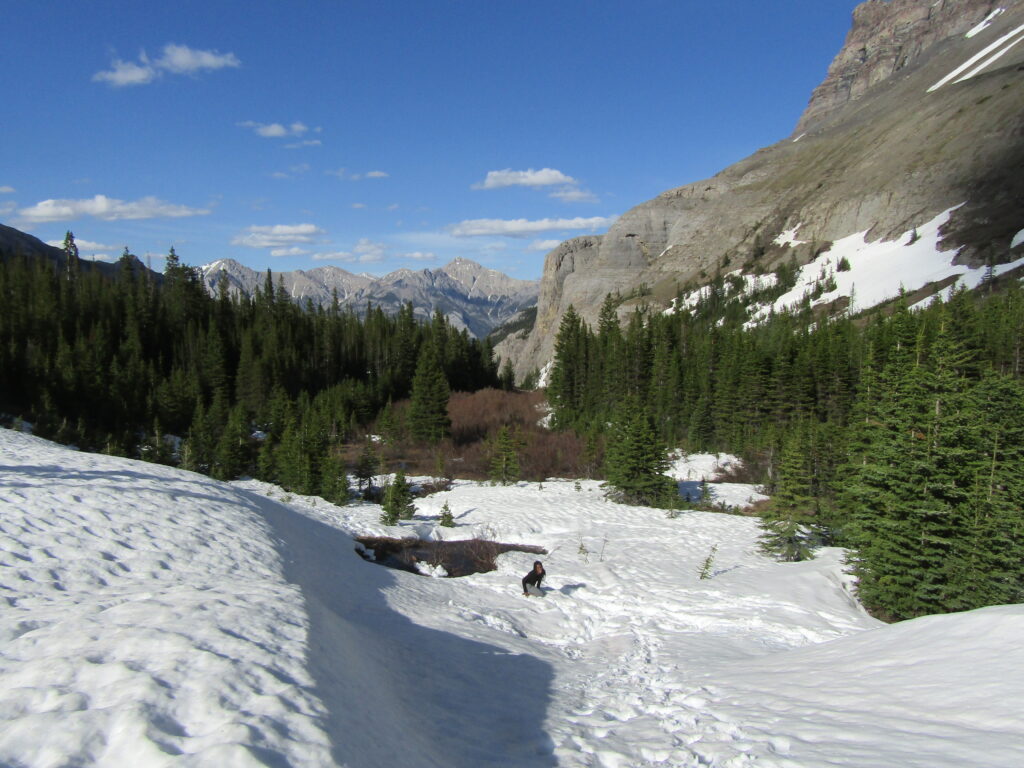Bourgeau Lake, Banff National Park
Distance: 9 miles (14.5km). Total elevation gain: 900m.
At the start of the hike, it was around 25-degrees Celsius. The trail begins under tall trees, offering us shade from the strong sun. What hit us first was the smell of the pine. I find it hard to describe, but my girlfriend, Steph, kindly shared her words: ‘it’s an earthy scent, with a dash of spice from the pinecones, with an almost Christmassy feel’.
I immediately felt closer to nature. But setting off, I felt a mixture of excitement and nervousness, taking on an unknown adventure. The thought of hiking in grizzly territory was pretty terrifying, so we invested in a recommended can of bear spray. A reminder of the wildlife around is displayed with the bear-proof bins – it’s very important to carry out anything you bring in and dispose of waste responsibly.
The hike starts with a steady incline up. It’s not a climb at first, but you should feel it in your thighs after a good four miles – ninety minutes for us – of constant uphill walking. Given the warnings of grizzlies, as well as the bear-proof bins, we were scared every wind-induced creaky tree, snap of a branch, rustle of leaves, flap of a tiny bird’s wings, or a squirrel scrambling up a trunk, was a bear creeping up on us.
Even when forgetting a bear would be hunting us, the real concern is that stumbling on a bear unexpectedly, worse yet with cubs, and it protects itself and its family. Fortunately, we only saw bears on this trip from the safety of our vehicle.

On this hike, we saw less than ten people. And we didn’t see anything more dangerous than a marmot, looking like an oversized meerkat on its hindlegs, alerting the other woodland critters of our presence, with a high-pitched squeak.
A few breaks in the forest along the way reveal a steep slope to the left of the trail, up to the mountain peaks. To the right, there is a ranging view above the tallest treetops, down to the valley floor, with the opposite mountain range in the distance. It gives perspective of how high up you are, when the peaks in the distance are at your eyeline. We could barely make out the shape of the road we were on less than two hours before. While the strain on our legs and lungs was kicking in, the views were worth it.

One hurdle along the way is a run-off from a waterfall that crosses the trail. It was substantial at the end of May, with snow thawing under the sun. We got our feet wet wading through the stream on the way up. On the way back, we found a tricky way round the water, involving a scramble on the mountain side through snow and ice.
After the waterfall, the climb becomes slightly steeper. The trail also becomes straighter, rather than circling the mountain to the top, and it is more of a direct route to the top. Although it may vary depending on the season, snow began to appear on the ground. At first, it came in patches, and no more than an inch. What was worse were patches of thin, slippery ice, making the rise more difficult.

The snow became gradually deeper. We had been warned by passers-by that the summit was barely reachable. We weren’t overconfident, but we thought we’d test ourselves.
The pace slowed dramatically as we came into snow that could be waist deep. There was some skill in placing your foot gently down on to the ground, to stop the whole leg going through. It didn’t always work.
The tingling sensation as your hand delves into the cold is the sharp reality of thick snow on the ground. The cold penetrates your skin then, excruciatingly, into your bones.
My only previous experience of snow was in the southwest of England, where it sets rarely, if at all. The best we ever managed as kids was a foot-tall snowman. Here, the snow was unrelenting. Not helped by not packing gloves, because – amateurishly – I didn’t expect snow on the ground at the onset of summer.

The shadow cast by the ever-closer mountains grew longer, as the afternoon passed by. Also, the wind increased as we climbed higher. All of which contributed to a noticeable drop in temperature. And with exhaustion from the hike up setting in, particularly the burn in the thighs, in the back of my mind was the fact every step up is an extra step back after.
The trees decline in size as the green turns into alpine higher up the mountains. An elevated ridge beyond the lake, almost like a natural wall, is in the distance. I knew the curved rock feature was the backdrop to the lake and it provided some reassurance that the destination wasn’t far.

We made an attempt to reach the pass, which is an additional hike in itself, but the snow became deeper. I almost lost my leg in the snow a couple of times, and it was more an effort to get it out – with my boot still on. Turning around, I saw Steph was in similar trouble. I didn’t realise at the time she wasn’t enjoying it so much anymore. I took a photo of her stuck in the snow, believing her scream and face of pain was in jest. It was only later that she told me her hands and feet were frozen, she’d lost her boot and couldn’t get her leg out.
I don’t think she’s forgiven me for taking a photo of her in her moment of suffering. We did at least agree that the experience, pushing ourselves to our physical limits in a challenging environment, was an unforgettable experience. While the photo serves as a good, and humorous, illustration of it.

We stumbled on the lake almost by accident. Pondering whether to turn back, we spotted an area of rocks and pebbles, without snow, where a small stream trickled by. Taking time to have a sit down, it was then just a short walk on the other side of the stream to the lake. Still frozen of for the most part, it reached back to the mountain ridge. We made it.
Returning down the mountain, while easier on the thighs, is often tougher on the knees. Although there is a mentality lift when you know you’re on the climb back down. I don’t usually enjoy going back on the same route, but climbing down a mountain gives me a sense of achievement knowing I was that high. Plus, I had the knowledge that I’m heading back to comfort and relaxation.

For the first hour of the descent, we had an almost clear view down the valley, which helped us forget some of the pain in the body. Photos don’t do the experience justice. The scenery ever changing as you progress down, the shape of the valley, the arrangement of the trees, the different features; waterfalls, rock formations, fallen trees, and the animals.
It was getting dark as we walked down for almost three hours, with aching ankle and knee joints. We did make it with about an hour of sunlight left. And Steph, to her credit and my gratitude, cooked for us. Before we set up camp in the car park, sleeping in the back of the jeep, under the mountains we had just hiked up.
